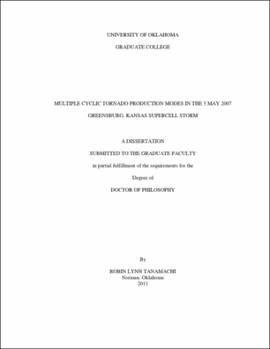| dc.contributor.advisor | Bluestein, Howard B | |
| dc.creator | Tanamachi, Robin L. | |
| dc.date.accessioned | 2019-04-27T21:21:14Z | |
| dc.date.available | 2019-04-27T21:21:14Z | |
| dc.date.issued | 2011 | |
| dc.identifier | 99120986002042 | |
| dc.identifier.uri | https://hdl.handle.net/11244/318475 | |
| dc.description.abstract | Long-track, violent tornadoes are rare events, but are responsible for a disproportionate majority of tornado fatalities, injuries, and property damage. It has been observed that such tornadoes are often generated as part of a series produced by one supercell, and preceded by one or more smaller tornadoes. At some point, a transition in the tornado production mode occurs, from short-track, cyclic tornado production (mode I), to long-track, single (plus satellite) tornado production (mode II). This transition has been documented only a few times at close range by Doppler weather radars. | |
| dc.description.abstract | A cyclic, tornadic supercell ("the Greensburg storm") generated at least 22 tornadoes in southwest Kansas on 5 May 2007. One of these was the first documented EF-5 tornado ("the Greensburg tornado"), which destroyed 95% of the buildings in Greensburg, Kansas and caused 11 fatalities. The University of Massachusetts X-band, polarimetric, mobile Doppler radar (UMass X-Pol), which was operating in the area as part of a severe storms research project, collected data in the Greensburg storm for over an hour, including its transition from tornado production mode I to mode II. The first 10 tornadoes produced by the Greensburg storm can be seen in this UMass X-Pol data set. | |
| dc.description.abstract | In this study, the UMass X-Pol data (as well as contemporaneous data from the WSR-88D at Dodge City, Kansas, or KDDC) are analyzed with the aim of diagnosing whether this transition occurred as a result of changes in the environmental wind profile, interaction of tornadoes with the storm's cold pool, or a combination of the two. These efforts met with limited success, largely because of the relative scarcity of observations of low-level flow in the inflow sector of the Greensburg storm. However, in the process, features of the Greensburg storm related to tornado production (such as vortices, updrafts, and polarimetric signatures) are documented, and relationships among them before, during, and after this transition are diagnosed. In particular, it is found that: | |
| dc.description.abstract | *The horizontal motions of the earlier tornadoes (mode I) tracked to the left with respect to the updraft motion, while the motion of the Greensburg tornado and its satellites (mode II) more closely matched that of the updraft. | |
| dc.description.abstract | *The vortex signatures in the UMass X-Pol data matched with the surveyed damage tracks. In addition, several non-tornadic circulations were documented. | |
| dc.description.abstract | *A forward surge and retreat of a RFGF was documented a few minutes before the development of the Greensburg tornado. | |
| dc.description.abstract | *At least two cyclonic-anticyclonic pairs of satellite tornadoes (of the Greensburg tornado) occurred, possibly indicating the upward arching of low-level horizontal vortex lines over bulges in the RFGF. | |
| dc.description.abstract | *Weak-echo holes are documented in several tornadoes, and found to be consistently collocated with corresponding vortex signatures in azimuth but biased slightly far from the radar in range. | |
| dc.description.abstract | *A polarimetric tornadic debris signature is found near the surface in the mature Greensburg tornado. In addition, a ZDR arc is documented whose presence corroborates increasing low-level vertical wind shear in the inflow sector. Other polarimetric supercell features are consistent with those found in previous studies. | |
| dc.description.abstract | In an attempt to retrieve in-storm variables not observed by radar, KDDC and UMass X-Pol radar data were assimilated into a numerical weather prediction model using the ensemble Kalman filter (EnKF) technique. Two sets of experiments were performed, one in which UMass X-Pol data were either included or withheld from assimilation with KDDC data, and another in which the 0 - 3 km AGL initial environmental wind profile was modified to include a low-level jet, or not. | |
| dc.description.abstract | Assimilation of UMass X-Pol data results in more pronounced changes to the analyses than the addition of a low-level jet, although both changes result in near-surface vortices that are stronger, deeper, and longer-lived than in experiments without. When UMass X-Pol data are assimilated, vortices appear in the analyses that correspond to mode I tornadoes, and the southward-spreading, surface cold pool from the Greensburg storm (which likely results from the use of a relatively simple microphysical parameterization scheme) deflects around the assimilated observations of southerly flow at the UMass X-Pol deployment site. Neither of these features appear when UMass X-Pol data are withheld. | |
| dc.description.abstract | I close by discussing the implications of these results for future avenues of research involving analysis and assimilation of data from mobile Doppler radars, including storm-scale prediction. | |
| dc.format.extent | 234 pages | |
| dc.format.medium | application.pdf | |
| dc.language | en_US | |
| dc.relation.requires | Adobe Acrobat Reader | |
| dc.subject | Tornadoes--Kansas--Greensburg | |
| dc.subject | Doppler radar | |
| dc.subject | Tornadoes | |
| dc.title | Multiple Cyclic Tornado Production Modes in the 5 May 2007 Greensburg, Kansas Supercell Storm | |
| dc.type | text | |
| dc.type | document | |
| dc.thesis.degree | Ph.D. | |
| ou.group | College of Atmospheric & Geographic Sciences::School of Meteorology | |
